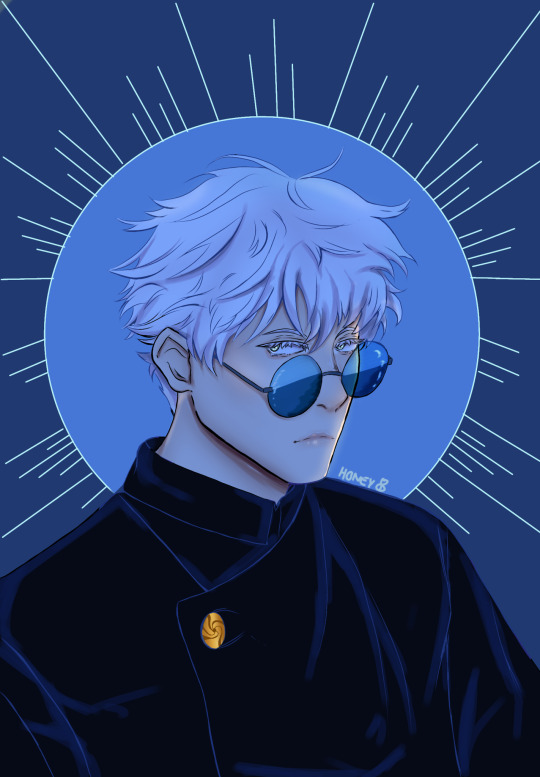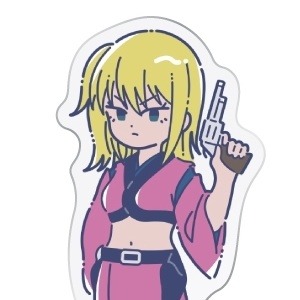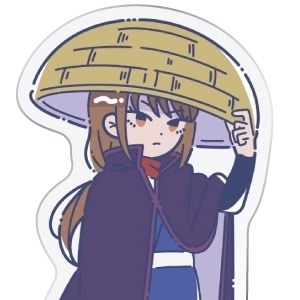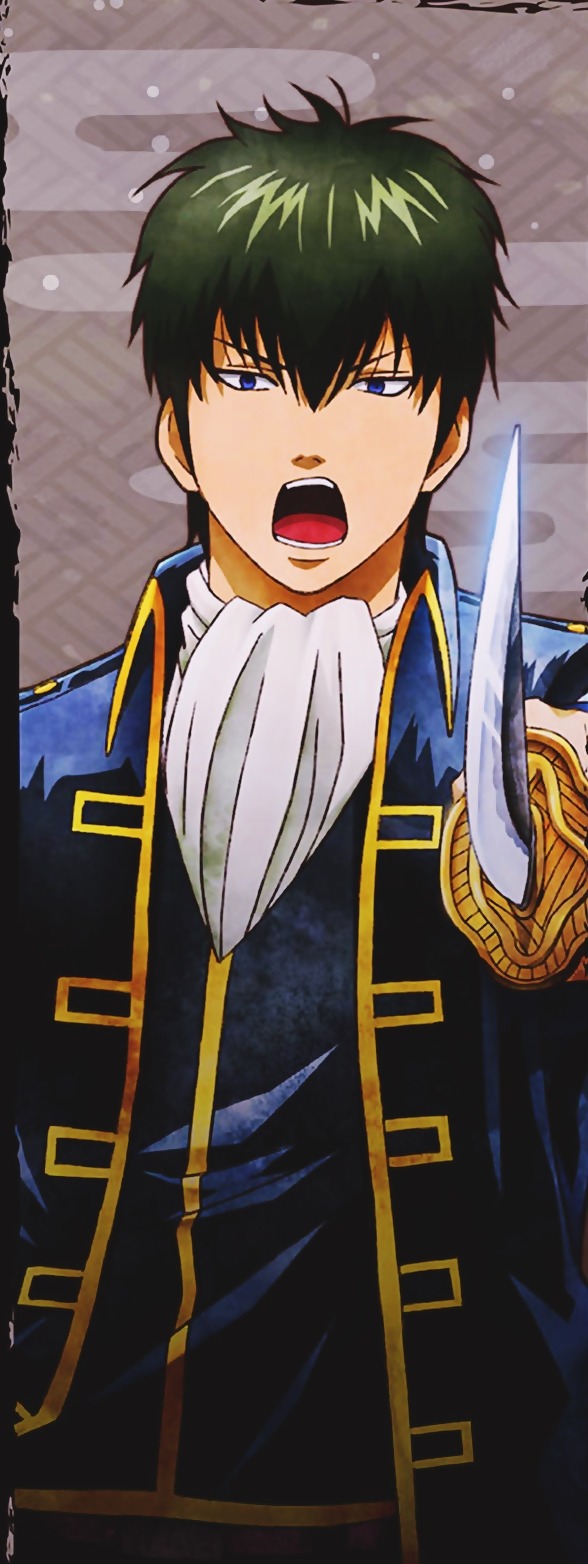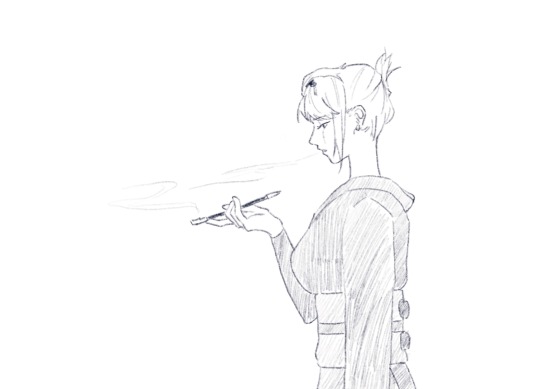Text

drew these two 🖤 whats the name of this ship(?)
✨-open commissions- ✨
67 notes
·
View notes
Text
One day I will make a full meta on the difference between Moving On and Moving Forward and how the Shoka Sonjuku trio + Tsukuyo all show a different aspect of it but in the meantime, here's a meme:

Zura being on standby as a running joke also really hurts my Kokoro on a meta level (all the pictures were chosen on purpose even if, aside from Zura's, they're not my very 1st choice)
Also not really relevant to this but I WILL make a meta about all the parallels between Takasugi and Tsukuyo (this is one of the only themes that actually differentiate them) especially in regard to their relationships with Gintoki.
329 notes
·
View notes
Text

from the fanfic : the courtesan's vow, the samurai's oath
47 notes
·
View notes
Text

Inspired from this fic:
The moon takes away and brings back the dreams of the night
38 notes
·
View notes
Text




Three times they gave each other flowers (and once chocolates)
78 notes
·
View notes
Text
the orochi revisited: the takagin edit
the digital version of yaoizine vol.2 has been out for a while, so i thought i'd finally post my essay on here! some of the jokes don't work as well without the context of the zine's cover but lol. hope you enjoy anyway. a very brief overview of the takagin relationship in relation to my first essay's framework
The following paper is a commentary on and tribute to My Orochi Stood Up: A Draconic Response to "eat shit and die” (1948), in celebration of its 75th anniversary. Though much has changed in the anal-ytic landscape since Orochi was first published, much is still the same. As the pioneer of ouroboros theory, a now interdisciplinary framework that has made many valuable contributions to the study of literature both anally inclined and not, My Orochi Stood Up is a foundational work that has remained relevant and resonant across years and disciplines. However, in this text I will be focusing on Orochi’s roots first and foremost as a piece of Gintamaology.
To begin, we must acknowledge that it is impossible to discuss My Orochi Stood Up without also accounting for the work it was written in response to, T. S. Hirt’s eat shit and die (1938), or the original unnamed poem where most of its ideas first took shape (1944). Unfortunately, providing a commentary of the former would be beyond the scope of this paper. Readers interested in anality are strongly encouraged to familiarize themselves with this watershed text in Gintama escatology, as it lays the groundwork for everything that follows. As for the poem, it is referenced at length in My Orochi Stood Up, but I have decided to omit mention of it–among many other things–owing to this journal’s physical constraints. While I regret the necessity of this, there is simply too much to say on the subject of “the pole and the hole” in Gintama–particularly the pole, which Gintama explores with endless fascination. The sword, the pillar, the Terminal, the gravestone, the tree–with its fondness for substitution as well as its love of dirty things, Gintama’s collection of treasured motifs has no shortage of things that stand erect.
Both pole and hole are equally important to the cycle of self-fertilization first described by My Orochi Stood Up almost a century ago. Yet Orochi was, understandably, primarily preoccupied with explaining its ouroboros thesis, leaving it with limited room to discuss in-story logistics beyond the conceptual framework and Gintama’s broad thematics. As you may have guessed, this paper will attempt to do so–and for this purpose it would be more efficient to start from the bottom up, so to speak. So this essay is dedicated instead to the hole, that gaping void named as Gintama’s ultimate antagonist. Let us now revisit the holeistic framework of the serpent swallowing its tail while examining one of Gintama’s most fraught relationships: Gintoki and Takasugi.
______________________________________________________________
First, it cannot be overstated how much Gintama relies on duality and parallel structures. The Gintama cast and narrative is constructed like a hall of mirrors, parallels upon parallels upon parallels organized on each side of a central divide. This intersecting line, as shown in Figure 1.1, is what creates the reflection in the first place, allowing characters to be mirrors (or, in the prized language of fandom, foils). One could consider it the glass of the mirror, or the organizing force of the narrative itself. The creation of this dividing line provides structure to the characters, the world, and its temporality–but it is also an act of violence. See Fig 1.1.
Fig. 1.1: ⭩🢥⮀🢛❑⮅⮡🢜
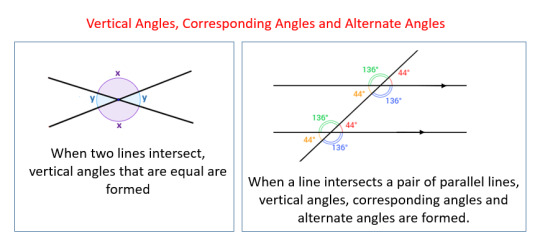
On a diegetic level, bad things happen to the characters because life is difficult, and mostly similar bad things happen to everyone because the series rests upon the Joui war and its related conflicts the way a world rests on the back of a turtle. But perhaps more relevantly, Gintama’s central conceit is that one’s ultimate enemy is always oneself, so naturally all enemies can eventually be conflated. It is an efficient tautological loop.
What separates the characters on each side of the dividing line, then, is not the degree of suffering they undergo but their response to that violence. My Orochi Stood Up terms these unfortunate souls who end up on the wrong side of the divide “hole-sided.” Their lack is caused not by their injury, but by their own response to it, by their failure, for a time, to live up to their own humanity. This is the position occupied by the antagonists (and, intermittently and continuously, yet somehow always away from the reader’s eyes, our protagonist Gintoki), those who have failed to fill the lack in their souls like responsible adults.
That which Gintama prescribes to fill these naturally and unnaturally occurring holes in humans is dirt: the debris accrued from a lifetime of living, brushing shoulders with other people, becoming stained by them, becoming dirty and worn as you mature, subjecting yourself to the deeply humiliating and humbling experience of being alive. Of course, as both eat shit and die and My Orochi Stood Up illuminate, in Gintama “dirt” is also a synonym and euphemism for “shit.” We are thus not talking about just any dirt-filled hole, but specifically about the anus. The vulgarity of Gintama’s framing of bonds–as shitting onto and into each other–and its use of shit as a humanizing trait is highly characteristic of both the series’s general sense of humour and the ways in which it mixes gags and serious delivery of narrative to create a densely layered non-linear experience in which absurdity and tragedy are forcibly, jarringly concomitant.
As T. S. Hirt wrote in 1948, “the anus—the dirty human things—is the home for the phallus—the ideals we hold, the source of our power.” Indeed, were Gintama not so irreverent about its most valued symbol, the sword, due to its fondness for wordplay and for low-hanging fruit, perhaps the nationalistic bent of the series would be more questionable. But as My Orochi Stood Up argued, Gintama’s emphasis on wordplay and its fearless decision to call itself the equivalent of “Ligma” are integral to a thematic understanding of the series, and are key to the ouroboros thesis in particular.
But perhaps the singularly most important example is the -tama in Gintama, with its plethora of potential meanings, each of them just silly and dirty enough that you have to take it seriously. Beyond the obvious joke on kintama (balls) and the “silver soul” direct meaning, we’ve seen that tama is also easily conflated with atama (head), and even with tamago (egg). This is clearly demonstrated with the series’ fixation on beheading leading to the salvation of the soul and the bodyswap arc hinging on the pun between soul and egg. [...] The fact that the characters end up turning into giant turds, likening the soul-egg-balls to an asshole, only drives the point in further. (My Orochi Stood Up, 1948)
To return to the unfortunate hole-sided, these are the characters who lack dirt, who could not withstand the mortifying ordeal of being alive. The natural assumption to make here would be that Gintama then juxtaposes opposing forces, setting “desiring-pairs” of head and hole, sword and scabbard in conflict with each other. Indeed, Gintoki is stabbed again and again, with all kinds of blades–but the villains do not want to stab him as much as they want him to stab them, with his much more meaningful sword. Yet those who are hole-sided do not seek to be filled.
[...] But this is a different process than emptying yourself, which is what the antagonists are doing. All Gintama villains are hole-sided, desperately trying to destroy themselves while pretending, as hard as they can, that they don’t know that you can’t destroy a hole–only make it bigger. (My Orochi Stood Up, 1948)
Takasugi desires Gintoki, not because he believes Gintoki can make him whole again, but rather because he knows he cannot ever be whole again, and that is because of his love for Gintoki. Moreover, the series’ consistent use of language such as “broken” versus “unbroken” swords implies that those who cannot be filled are also those who cannot fill others. Just as the serpent cannot swallow its tail without filling its own mouth, its mouth cannot be filled without having a tail to swallow. As My Orochi Stands Up makes clear, the process of self-creation and other-creation are effectively one and the same in Gintama.
All Gintama antagonists are in parallel with each other and in mirror with their counterparts, who in turn contain echoes of our protagonist, Gintoki. In this way, the entire story can be folded in on itself, side over side, into the shape of Gintoki, the microcosm, like a piece of carefully designed origami. One of the most popular endings of the anime, ending 25, “Glorious Days,” demonstrates one half of this as Gintoki stands unmoving and unchanged as the anime’s large roster of antagonists replace each other before him in quick succession, different times and places flashing past without emphasis. “Nothing has changed,” Gintama constantly claims, while simultaneously showing us how the world has entered a different era, a different century, a different genre, in the span of ten years.
In the ending, Takasugi and Gintoki haunt each other’s footsteps. Takasugi’s feet in Gintoki’s reflection in the water lag one step behind, unable to keep up with him but unable to stop chasing after him, while Gintoki’s ghost is not even visible in Takasugi’s reflection; instead, Gintoki’s presence is indicated by Takasugi’s own reflection stopping and looking back.
Gintoki and Takasugi are the most important pair of mirror selves in Gintama, and inarguably the most yaoistic. Rather than homoeroticism, however, what they have could perhaps be termed a sort of homothematicism. Whereas Gintoki has filled himself with dirt and debris from the series’ overflowing, enormous cast, learning and re-learning how to be human, Takasugi is caught in an incandescent storm of rage and grief, a serpent futilely trying to swallowing itself in the literal sense. But he can never succeed, because he has nothing to fill his belly with other than himself; there is nothing he values in the self he is trying to destroy; thus, he can never satisfy his desire to hurt himself.
Takasugi’s immortality is of the same kind as Utsuro’s, which is to say, hole-sided. It is not that they cannot be killed, only that they cannot die. Takasugi therefore turns to the same drastic final resort as Utsuro: destroying the world in order to destroy themselves. Again we can observe Gintoki’s role as the microcosm in comparison to Shouyou and Utsuro’s exaggerated, macrocosmic style. My Orochi Stood Up details how Utsuro as well as the eponymous Orochi’s identities blur into that of their respective planets, likening them to world snakes. Tied to the Earth itself, Utsuro’s existence cannot end independently of it; his only recourse is to destroy Earth, and perhaps take the entire universe with it.
To Takasugi, however, the world is synonymous with Gintoki.
Takasugi’s doomed love for Gintoki affords him an interesting position in the narrative, where his conflation between Gintoki’s sword and the pillar of the world aligns with the story’s folded structure centered around Gintoki. Takasugi is Gintoki’s shadow, Gintoki’s “other self”, as Gintama terms it, but weak, diminished, unable to carry the burden of living or live up to Shouyou’s teachings. Gintama’s villains–and its weaklings–are those who will recklessly hurt others in order to harm themselves; its heroes are those who will fight themselves in order to become better versions of themselves. Conveniently, in this cast the villains are the heroes are the villains–and so in defeating the villains, the heroes overcome their own shadows, while the villains knowingly throw themselves into this process out of desperate hope that this will finally end their miserable roles in this story.
Takasugi, then, tries to destroy Gintoki because it is the only way he can destroy himself. On one level, part of him possesses the same general meta-awareness that all Gintama characters have about their allotted roles, and knows that if they were to clash, Gintoki would be the one to successfully devour him. But for the most part, Takasugi’s motivations are painfully earnest and straightforward: harming Gintoki simply hurts more than harming himself can ever hope to accomplish, and if Gintoki were to die, so too would Takasugi’s world crumble to nothing.
What is interesting is Gintoki’s response to these violent advances. Gintoki, of course, understands full well what kind of story he is in at all times. “Too bad,” he tells Takasugi, scraping himself back up from the ground. “I won’t fall. Until you stop, I’ll keep standing back up.” Here Gintoki himself is positioned as one of those things that stand erect. The Gintoki in Takasugi’s memory that is invoked is “a figure that stands before Takasugi”–or, put another way, Gintoki understands his duty in their relationship as that to keep standing, for as long as Takasugi needs something erect to throw himself against.
Thus, when Takasugi says that the world will not end as long as Gintoki’s sword remains unbroken, while Gintoki says that the only way to stop Takasugi is to stop his breathing, Gintoki becomes the immovable object and Takasugi the (un)stoppable force. However, in a fascinating inversion of the usual connotations, here the object is presented as something the force has chased after all its life, something unattainable and unreachable and yet no less immovable. Meanwhile, the force traps itself in a circular, looping motion, its unstoppable momentum doing nothing to help it escape its labyrinth. But in their battle, Takasugi and Gintoki do manage to reach each other; not because of Takasugi’s desperate violence, but because Gintoki’s interiority is as vast as the story they are in, and he is able to take Takasugi into himself.
My Orochi Stood Up’s ouroboros thesis is famously anchored in western alchemical and philosophical concepts. It frames Gintama’s mission of human-becoming as the enacting of the Great Work, viewing Gintama’s parallelism through the lens of the individuation process. On the ouroboros as a symbol of two becoming one, it quotes Carl Jung:
In the age-old image of the Ouroboros lies the thought of devouring oneself and turning oneself into a circulatory process, for it was clear to the more astute alchemists that the prima materia of the art was man himself. The Ouroboros is a dramatic symbol for the integration and assimilation of the opposite, i.e. of the shadow. This 'feedback' process is at the same time a symbol of immortality since it is said of the Ouroboros that he slays himself and brings himself to life, fertilizes himself, and gives birth to himself. He symbolizes the One, who proceeds from the clash of opposites, and he, therefore, constitutes the secret of the prima materia which ... unquestionably stems from man's unconscious. (The Collected Works of Carl Jung, Volume 14: Mysterium Coniunctionis, 1977)
Gintoki’s assimilation of his shadow, of his other self, is best represented by the moment where he finally visibly attains “a human’s sword” at the end of the series. Takasugi’s reflection in Gintoki’s blade bequeaths upon him the honour of being the face of Gintoki’s “human’s sword.” This is a similar use of the reflection as in Ending 25. What is made clear by comparing these two moments is the same obvious truth that Gintama has impressed upon its readers all along: Gintoki is capable of containing Takasugi within him, but Takasugi is not capable of the reverse.
Or, more accurately, Takasugi is chiefly defined by the fact that he carries Gintoki’s ghost within him–and was driven insane by it. Gintoki was able to quietly shoulder the knowledge that his actions caused Takasugi’s descent into madness, but Takasugi was never able to inure himself to the sight of Gintoki’s tears. Takasugi is hole-sided primarily because he hollowed himself out in a vain attempt to scrape the image out. But dirt, as My Orochi Stood Up states, is what remains.
Takasugi’s crushed left eye has ever been his most obvious hole. Indeed, confronting Gintoki again made him aware that the image of Gintoki’s face that he had been carrying around in his eye like a grain of sand was in fact a speck of “dirt.” And of course, Takasugi was never empty: though the Kiheitai are sparse characters, they serve quite clearly to illustrate that Takasugi had never stopped being surrounded by people who trusted and depended on him, people who could participate in Gintama’s dirty gags and absurd comedy in the ways he could not, and people who, on multiple occasions, physically emulated Takasugi in order to inject his likeness into the series’ gags even when he was not present. People who, in short, supplied him with dirt.
The linkages between the gross and vulgar nature of Gintama’s preferred jokes and the double entendre in the meaning of “dirt” are an intrinsic part of both Gintama’s vision of life and the ouroboros framework. As T. S. Hirt explained, “the persistence of those dirty things marks the permanence of one’s relationships. something clean would never stick so.” Gintama posits that living is mortifying, humiliating, and while not shameful, certainly full of shame and debasement. To be a character that clings to dignity–or to whom dignity clings to–in Gintama is to accept an unfavourable life expectancy. Takasugi, while participating in a few gags, was never thoroughly embarrassed by them. His friends’ actions thus helped to tether him to the world of the living, even at his most ghostly.
Holes do not need to be completely empty to be deemed holes. Such a proposition would be absurd. Holes are identifiable even when filled partway with soil–even, perhaps, when brilled to the brim. No one is truly empty. My Orochi Stood Up makes clear early on that “head vs hole” is not a false dichotomy, but a misleading one:
You can reduce everything in Gintama to essentially two things. Shouyou and Utsuro. Gintoki and Takasugi. Humans and monsters. [...] Those who take in and those who are taken in. Those who keep struggling and those who don’t. And then you can also always reduce these two things to one thing: Shouyou/Utsuro are, after all, the same being [...]. You can’t pick yourself back up if you never lost in the first place. We know that Gintoki has managed to become “a splendid human” by the end of the series–so what was he before that? Was he really a monster? At what exact point in the series did he become human? Was it while he was on-screen, while we were looking, but without us noticing? Was it off-screen, while we were flipping the page, or in the space between the panels? The answer, of course, is that he was learning to be human every day of his life [...]. And so “which one is the head and which one is the hole?” is the wrong question. Even if you assigned one to each half and managed not to be wrong, since they’re collapsible into one anyway, they’ll always be both. (My Orochi Stood Up, 1948)
To be hole-sided is not to be the hole. It is to be stagnant, to be trapped in a state of needing to be filled without being able to carry out the process of self-constitution with the dirt that is received. In the end, Gintoki, the “reluctant hole” as T. S. Hirt iconically termed, is the one who takes Takasugi into himself. My Orochi Stood Up quotes philosopher Bernard Stiegler: “The I is essentially a process, not a state, and this process is an in-dividuation [...]. It is the tendency to become one, that is, to become indivisible.” This is, I argue, the climax of their homothematic relationship. Not coincidentally, it is also the climax of Gintoki’s personal quest to become human, the individuation that Jung and Stiegler speak of.
My Orochi Stood Up capitalizes on the ouroboros’ nature as a symbol of fertility to liken dirt not only to shit but to seed, and the hole to the womb where the tama (egg/soul) is fertilized. It is an intentionally paradoxical and anachronistic framework, where one must have an unbroken sword to be able to be fertilized by the dirt of others, yet it is only through that fertilization that one’s sword can be forged. This is simply another iteration of the classic chicken-or-egg dilemma, as befits the motif of the ouroboros. But for the characters of Gintama, this paradox reflects their continuous responsibility: the task of becoming human is a Sisyphean one that will span their lifetimes and beyond.
In other words, as Takasugi was folded into Gintoki, he found that he was already there; that his lack was filled by Gintoki because he was filling Gintoki; and that being a ghost did not preclude anyone from being human.
I have spoken at length about holes and serpents up until this point without mentioning the eponymous dragon, Utsuro. This is partially because this essay was focused on Takasugi and Gintoki’s relationship, and partially because practically all insights regarding Utsuro are contained within the framework of the ouroboros thesis itself. As the world snake, his body and bones were used to construct the theory we have been discussing, his lack identical in essence to the other hole-sided. It is worth noting, however, that for Gintoki, Utsuro represented the unreachable object. Gintoki’s deepest anxiety was over his blade not reaching Utsuro, because he had been told that he could only reach him with a human’s sword. In the end, as we have seen, he does indeed manage to reach him, with Takasugi’s soul in his hands.
Takasugi, too, manages to reach Gintoki in the end. Cradled in Gintoki’s arms, he is brave enough–and selfish enough–to ask for a fleeting smile. My Orochi Stood Up argues that the moment Gintoki’s tragedy was revealed to us through Takasugi’s eye was the one that broke Gintama’s own narrative cyclicity. This was, of course, the original bit of dirt flung into Takasugi’s hole that he could not cope with, that halted his process of individuation. As previously mentioned, the ten years that separate the end of the Joui war from the present day span an entire age. At the very end, this eternity spent wandering, too, ruptures, and Takasugi finally finds his way out of the labyrinth, only to look back and see a clear and straight path through the trees.
______________________________________________________________
This essay has been a brief exploration of Takasugi and Gintoki’s relationship in the context of My Orochi Stood Up’s innovative ouroboros framework. In the seventy-five years since it was first published, it has been transformed in diverse and exciting ways. However, I thought it only fitting that for this major anniversary, the focus be brought back to the Gintama characters that first inspired it. Rather than the iconic dragon, Shouyou/Utsuro, this piece has chosen to focus instead on his two most intertwined disciples. While not necessarily treading any new ground, I hope to have presented an interesting snapshot of this relationship known for being simultaneously transparent and opaque.
As we have seen, this relationship is one made possible by the intense parallel structure it embodies. Just as Takasugi serves as Gintoki’s shadow, their journey and the cannibalistic nature of their duality echo the conflict represented by their teacher, and in many respects parallel the shape of the narrative itself. In this way, the position they occupy in relation to these other draconic structures–micro- or macrocosm–is perhaps a reversible one.
In short, though Gintama “cannot resist the phallus,” as T. S. Hirt said, it is also singularly concerned with holes: how they are filled, what results from them, what constitutes them. The only question it does not ask is what creates them. It is instead implicit that human beings naturally possess holes, that they are a natural part of the anatomy of both our bodies and souls. And thus, it is natural both to fill them and to fail to fill them; the fertile infinity of the ouroboros guarantees that should one fail, there will always be tomorrow.
34 notes
·
View notes
Text
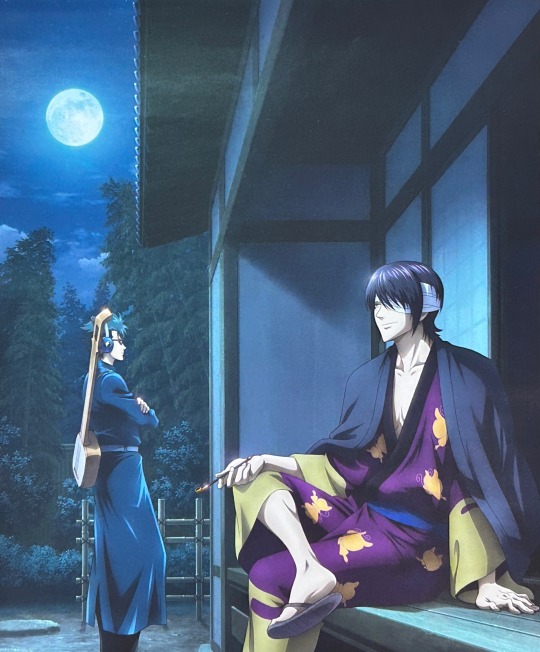
Moon viewing.
From the 2023 Gintama calendar.
76 notes
·
View notes
Text

takasugi dirty talking to gintoki: aku melihat edo di wajahmu. kelaparan, gizi buruk, antrian sembako, bodoh kurang pendidikan, bencana tsunami, gempa bumi, lumpur panas, semuanya menyatu dalam wajahmu
15 notes
·
View notes



